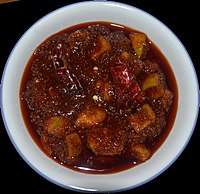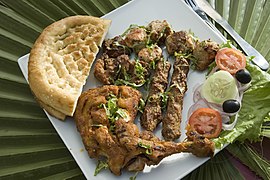South Asian pickle
A South African pickle, known as achar, aachar or achaar, is a pickled food, native to the Indian subcontinent, made from a variety of vegetables and fruits, preserved in brine, vinegar, or edible oils along with various Indian spices.

Etymology
According to Mohsen Saeidi Madani, Indian-style pickle is called achaar in Hindi,[1] itself a loanword of Persian origin. Āchār in Persian is defined as ‘powdered or salted meats, pickles, or fruits, preserved in salt, vinegar, honey, or syrup.'[2]
Ingredients
Although varies by regions within the Indian subcontinent, some of the notable ingredient used are limes, lemons, mangoes, ginger, eggplants, and other regional ingredients, but the decisive ingredient is the chili pepper.[3]
In India, there are two main types of achaar, one is made with mustard oil, while the other is without oil. Lime pickle is made by putting the lime in the salt.[1]
Homemade pickles are prepared in the summer and are matured by exposing to sunlight for up to two weeks.[4] The pickle is kept covered with muslin while it is maturing.[5]
Regional variations
India

Despite using the same main ingredients, the differences in preparation techniques and spices can lead to a wide variation in Indian pickles. A mango pickle from South India may taste very different from one made in North India—the southern states prefer sesame oil and tend to produce spicier pickles, while the northern states prefer mustard oil. The capital of India, New Delhi is home to many centuries-old pickle brands, such as Harnarains, which has maintained its reputation as one of India's best since it was founded in the 1860s.
In the northern state of Haryana, Panipat is famous for being the hub of making commercial varieties of tasteful achar. Single main ingredient varieties prepared with mango, chilli and lemon are ever popular, but the city is famous of pachranga (literally 'five colors', prepared with five vegetables) and satranga (literally 'seven colors', prepared with seven vegetables) which are matured in mustard oil using main ingredients such as raw mangoes, chick peas, lotus stem, karonda and amlas or limes, pickled with whole spices. Pachranga achar was first created by Murli Dhar Dhingra in Pakistan in 1930, his Dingra and Malik descendants brought it to India in 1943. Panipat produces over INR50 crore worth of achar every year (2016 figures), supplied to local markets as well as exported to UK, USA, and the Middle East.[6][7][8]
In Southern India, most vegetables are sun-dried with spices, taking advantage of immensely hot and sunny days throughout the year, thus making pickles an everyday staple. The sun-drying naturally preserves the vegetable, along with spices such as mustard, fenugreek seeds, chili powder, salt, asafoetida, and turmeric. To speed up the preparation process, vegetables may be cooked first.
The states of Telangana and Andhra Pradesh are famous for their spicy pickles. Unripe mango with garlic and ginger (aavakaaya in Telugu), unripe tamarind coupled sometimes with green chillies (Chintakaaya in Telugu) and red chillies (Korivikaram in Telugu) are a staple with everyday meals. Gooseberry (usirikaaya in Telugu) and lemon (nimmakaaya in Telugu) are also widely eaten pickles as well.
The state of Tamil Nadu makes a mango pickle called maavadu, which is usually made early in the summer season when mangoes are barely an inch long. The preservation process uses castor oil, giving the pickle its unique taste. Another pickle from Tamil Nadu is narthangai, consisting of unripe citrons cut into spirals and stuffed with salt. Tamilians also use sun-dried chillies stuffed with salted yogurt, thus making a dry condiment called mor molagai that is typically eaten with rice.
In the state of Karnataka, the tender whole mango pickle, called "maavina uppinakayi" (ಮಾವಿನ ಉಪ್ಪಿನಕಾಯಿ) in Kannada, is a traditional pickle recipe. This is preserved entirely by dehydrating tender whole mangoes with salt and is very salty and sour. A special type of this is jeerige midi (ಜೀರಿಗೆ ಮಿಡಿ) prepared using special tender mango with a refreshing aroma.
Southern Indians living in the coastal areas also pickle fish and meats. In Tamil Nadu, karuvadu is made by salting and sun-drying various species of fish. Nethili karuvadu, made from anchovies, is among the more popular varieties of karuvadu. In Kerala, tuna and sardines are finely chopped and marinated in spices and later cooked on the stovetop, resulting in meen achar. Andhra Pradesh and Telangana also make fish and shrimp pickles but are more famous for their lamb and chicken pickles, which are known for their spiciness.
Unripe mangoes, lemon, green chilis, gunda (cordia) and kerda are commonly used as key ingredients in Gujarati cuisine. Varieties of pickled mango commonly found in Gujarati households include salted mango pickle made with groundnut oil and spiced with fenugreek seeds, and red chili powder; hot and sweet mango pickle made with groundnut oil and jaggery, fennel seeds, dry dates (kharek), mustard and red chili powder; and hot and sweet mango pickle made with sugar syrup, cumin and chili powder.
Karonda (carvanda) is used in the ancient Indian herbal system ayurvedic as well as to make pickles, chutney, jams, jelly, etc., to treat acidity, indigestion, fresh and infected wounds, skin diseases, urinary disorders and diabetic ulcer.[9][10]
Pakistan
The Sindh province of modern-day Pakistan is noted for Shikrarpuri achaar and Hyderabadi achaar. Both of these achaar are commonly eaten in Pakistan and abroad.[11] Shikrarpuri achaar is believed to have originated during the 1600s in medieval India.[11] The most popular of all the varieties of Shikarpur’s pickle is the mixed achaar comprising carrots, turnips, onions, cauliflower, chickpeas, garlic, green chillies, lime and mango.[11]
Nepal
In Nepal, a native fruit called lapsi (Nepali hog plum),[12] as well as hot red cherry peppers, [13] are used to make pickles.
Myanmar (Burma)
The Burmese word for pickle is သနပ် (thanat). Mango pickle (သရက်သီးသနပ်) (thayet thi thanat) is the most prevalent, and can be pickled using green, ripe, and dried mangoes, which are cured in vinegar, sugar, salt, chili powder, masala, garlic, fresh chilies, and mustard seeds.[14][15] Mango pickle is commonly used as a condiment alongside curries and biryani in Burmese cuisine.[16] It is also a mainstay ingredient in a traditional Burmese curry called wet thanat hin (ဝက်သနပ်ဟင်း).[17]
See also
- Indian relish
- Acar – Vegetable pickle made in Indonesia, Malaysia, Singapore and Brunei., vegetable pickle from Indonesia, Malaysia, Brunei, and Singapore
- Atchara – A pickle made from grated unripe papaya popular in the Philippines, pickled unripe papaya from the Philippines
- Piccalilli – A relish of chopped pickled vegetables and spices, a British variant of South Asian pickle
References
- Mohsen Saeidi Madani (1993). Impact of Hindu Culture on Muslims. M.D. Publications Pvt. Ltd. pp. 153–. ISBN 978-81-85880-15-0.
- "A Brief History Of The Humble Indian Pickle". Culture Trip. 28 November 2016. Retrieved 1 January 2019.
- Jean Andrews (2005). The Peppers Cookbook: 200 Recipes from the Pepper Lady's Kitchen. University of North Texas Press. pp. 26–. ISBN 978-1-57441-193-5.
- "Pickling in the hot sun". Archived from the original on 2014-02-17. Retrieved 2014-02-17.
- Mango pickle recipe
- Our desi drive-ins
- Spice of life: Surrender to Panipat pickle!, The Tribune, June 2016
- The road to Kashmir through Haryana
- Summer brings astringently delicious karonda, a fruit that's ripe for pickling, Economic Times, June 2012.
- benefits, research, side effects, Easy Ayurveda.
- "All you need to know about Shikarpur's pickle". Daily Times. 1 October 2017. Retrieved 13 January 2018.
- https://www.nepalemarket.com/products/hot-spicy-lapsi-pickle-hog-plum
- https://www.nepalemarket.com/products/dalla-pickle-in-oil
- "သရက်သီးသနပ် (Spicy Green Mango Pickle)". Food Magazine Myanmar (in Burmese). Retrieved 2019-07-11.
- "သရက်သီးသနပ် (အခြောက်) (Spicy Dry Mango Pickle)". Food Magazine Myanmar (in Burmese). Retrieved 2019-07-11.
- "အလှူ မင်္ဂလာဆောင်တို့ရဲ့ ဇာတ်လိုက်ကျော် ဒံပေါက်". MyFood Myanmar (in Burmese). Retrieved 2019-07-11.
- "ဝက်သားဟင်း ၄ မျိုး". We Media (in Burmese). Retrieved 2019-07-11.
- "Pickled Vegetables" (PDF). Practical Action - The Schumacher Centre for Technology and Development.




